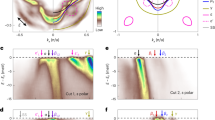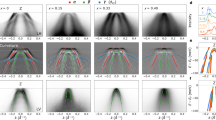Abstract
Pairing symmetry is a fundamental property that characterizes a superconductor. For the iron-based high-temperature superconductors1,2, an s±-wave pairing symmetry has received increasing experimental3,4,5,6,7,8,9,10,11 and theoretical12,13,14,15,16,17,18,19,20,21 support. More specifically, the superconducting order parameter is an isotropic s-wave type around a particular Fermi surface, but it has opposite signs between the hole Fermi surfaces at the zone centre and the electron Fermi surfaces at the zone corners. Here we report the low-energy electronic structure of the newly discovered superconductors, AxFe2Se2 (A=K,Cs) with a superconducting transition temperature (Tc) of about 30 K. We found AxFe2Se2 (A=K,Cs) is the most heavily electron-doped among all iron-based superconductors. Large electron Fermi surfaces are observed around the zone corners, with an almost isotropic superconducting gap of ~10.3 meV, whereas there is no hole Fermi surface near the zone centre, which demonstrates that interband scattering or Fermi surface nesting is not a necessary ingredient for the unconventional superconductivity in iron-based superconductors. Thus, the sign change in the s± pairing symmetry driven by the interband scattering as suggested in many weak coupling theories12 becomes conceptually irrelevant in describing the superconducting state here. A more conventional s-wave pairing is probably a better description.
This is a preview of subscription content, access via your institution
Access options
Subscribe to this journal
Receive 12 print issues and online access
$259.00 per year
only $21.58 per issue
Buy this article
- Purchase on Springer Link
- Instant access to full article PDF
Prices may be subject to local taxes which are calculated during checkout





Similar content being viewed by others
References
Kamihara, Y., Watanabe, T., Hirano, M. & Hosono, H. Iron-based layered superconductor La[O1−xFx]FeAs (x=0.05–0.12) with Tc=26 K. J. Am. Chem. Soc. 130, 3296–3297 (2008).
Chen, X. H. et al. Superconductivity at 43 K in SmFeAsO1−xFx . Nature 453, 761–762 (2008).
Ding, H. et al. Observation of Fermi-surface-independent nodeless superconducting gaps in Ba0.6K0.4Fe2As2 . Europhys. Lett. 83, 47001 (2008).
Terashima, K. et al. Fermi surface nesting induced strong pairing in iron-based superconductors. Proc. Natl Acad. Sci. USA 106, 7330–7333 (2009).
Zhang, Y. et al. Out-of-plane momentum and symmetry dependent superconducting gap in Ba0.6K0.4Fe2As2 . Phys. Rev. Lett. 105, 117003 (2010).
Christianson, A. D. et al. Unconventional superconductivity in Ba0.6K0.4Fe2As2 from inelastic neutron scattering. Nature 456, 930–962 (2008).
Qiu, Y. et al. Spin gap and resonance at the nesting wave vector in superconducting FeSe0.4Te0.6 . Phys. Rev. Lett. 103, 067008 (2009).
Hanaguri, T., Niitaka, S., Kuroki, K. & Takagi, H. Unconventional s-wave superconductivity in Fe(Se, Te). Science 328, 474–476 (2010).
Kondo, T. et al. Momentum dependence of the superconducting gap in NdFeAsO0.9F0.1 single crystals measured by angle resolved photoemission spectroscopy. Phys. Rev. Lett. 101, 147003 (2008).
Wray, L. et al. Momentum dependence of superconducting gap, strong-coupling dispersion kink, and tightly bound Cooper pairs in the high-Tc(Sr,Ba)1−x(K,Na)xFe2As2 superconductors. Phy. Rev. B 78, 184508 (2008).
Borisenko, S. V. et al. Superconductivity without nesting in LiFeAs. Phys. Rev. Lett. 105, 067002 (2010).
Mazin, I. I. & Schmalian, J. Pairing symmetry and pairing state in ferropnictides: Theoretical overview. Physica C 469, 614–627 (2009).
Seo, K., Bernevig, B. A. & Hu, J. P. Pairing symmetry in a two-orbital exchange coupling model of oxypnictides. Phys. Rev. Lett. 101, 206404 (2008).
Wang, F. et al. A functional renormalization group study of the pairing symmetry and pairing mechanism of the FeAs based high temperature superconductors. Phys. Rev. Lett. 102, 047005 (2009).
Kuroki, K. et al. Unconventional pairing originating from the disconnected Fermi surfaces of superconducting LaFeAsO1−xFx . Phys. Rev. Lett. 101, 087004 (2008).
Kuroki, K. Anion height as a controlling parameter for the superconductivity in iron pnictides and cuprates. Preprint at http://arxiv.org/abs/1008.2286 (2010).
Thomale, R. et al. Functional renormalization-group study of the doping dependence of pairing symmetry in the iron pnictide superconductors. Phys. Rev. B 80, 180505 (2009).
Thomale, R., Platt, C., Hanke, W. & Bernevig, B. A. Why some iron-based superconductors are nodal while others are nodeless. Preprint at http://arxiv.org/abs/1002.3599 (2010).
Yao, Z-J., Li, J-X. & Wang, Z. D. Spin fluctuations, interband coupling and unconventional pairing in iron-based superconductors. New J. Phys. 11, 025009 (2009).
Lu, X., Fang, C., Tsai, W-F., Jiang, Y. & Hu, J. P. S-wave superconductivity with orbital dependent sign change in the checkerboard models of iron-based superconductors. Preprint at http://arxiv.org/abs/1012.2566 (2010).
Berg, E., Kivelson, S. A. & Scalapino, D. J. A twisted Ladder: Relating the iron superconductors and the high Tc cuprates. Phys. Rev. B 81, 172504 (2010).
Sato, T. et al. Band structure and Fermi surface of an extremely overdoped iron-based superconductor KFe2As2 . Phys. Rev. Lett. 103, 047002 (2009).
Dong, J. K. et al. Quantum criticality and nodal superconductivity in the FeAs-based superconductor KFe2As2 . Phys. Rev. Lett. 104, 087005 (2010).
Zhang, Y. et al. The orbital characters of bands in iron-based superconductor BaFe1.85Co0.15As2 . (in the press); preprint at http://arxiv.org/abs/0904.4022.
Shimojima, T. et al. Orbital-dependent modifications of electronic structure across the magnetostructural transition in BaFe2As2 . Phys. Rev. Lett. 104, 057002 (2010).
Vildosola, V. et al. Bandwidth and Fermi surface of iron oxypnictides: Covalency and sensitivity to structural changes. Phys. Rev. B 78, 064518 (2008).
Guo, J. et al. Superconductivity in the iron selenide KxFe2Se2(0≤x≤1.0). Phys. Rev. B 82, 180520 (2010).
Mizuguchi, Y. et al. Transport properties of the new Fe-based superconductor KxFe2Se2 (Tc=33 K). Appl. Phys. Lett. 98, 042511 (2011).
Krzton-Maziopa, A. et al. Synthesis and crystal growth of Cs0.8(FeSe0.98)2: A new iron-based superconductor with Tc=27 K. J. Phys. Condens. Matter 23, 052203 (2011).
Ying, J. J. et al. Superconductivity and magnetic properties of high-quality single crystals of AxFe2Se2 (A=K and Cs). Preprint at http://arxiv.org/abs/1012.5552 (2010).
Shein, I. R. & Ivanovskii, A. L. Electronic structure and Fermi surface of new K intercalated iron selenide superconductor KxFe2Se2. Preprint at http://arxiv.org/abs/1012.5164 (2010).
Chen, F. et al. Electronic structure of Fe1.04Te0.66Se0.34 . Phys. Rev. B 81, 014526 (2010).
Nekrasov, I. A. & Sadovskii, M. V. Electronic structure, topological phase transitions and superconductivity in (K,Cs)xFe2Se2 . Pisma ZhETF 93, 182–185 (2011).
Qian, T. et al. Absence of holelike Fermi surface in superconducting K0.8Fe1.7Se2 revealed by ARPES. Preprint at http://arxiv.org/abs/1012.6017 (2010).
Acknowledgements
This work is supported in part by the National Science Foundation of China, Ministry of Education of China, Science and Technology Committee of Shanghai Municipal, and National Basic Research Program of China (973 Program) under grant Nos. 2011CB921802 and 2011CBA00102.
Author information
Authors and Affiliations
Contributions
ARPES measurements were done by Y.Z., L.X.Y., M.X., Z.R.Y., F.C., C.H., H.C.X., J.J. and B.P.X. M.M. and S.K. helped with the experiment at UVSOR. J.J.Y., X.F.W. and X.H.C. provided the samples. Y.Z., L.X.Y. and D.L.F. analysed the ARPES data. J.P.H. and D.L.F wrote the paper. D.L.F. was responsible for project direction, planning and infrastructure.
Corresponding author
Ethics declarations
Competing interests
The authors declare no competing financial interests.
Supplementary information
Supplementary Information
Supplementary Information (PDF 678 kb)
Rights and permissions
About this article
Cite this article
Zhang, Y., Yang, L., Xu, M. et al. Nodeless superconducting gap in AxFe2Se2 (A=K,Cs) revealed by angle-resolved photoemission spectroscopy. Nature Mater 10, 273–277 (2011). https://doi.org/10.1038/nmat2981
Received:
Accepted:
Published:
Issue Date:
DOI: https://doi.org/10.1038/nmat2981
This article is cited by
-
Nodal s± pairing symmetry in an iron-based superconductor with only hole pockets
Nature Physics (2024)
-
Vertex dominated superconductivity in intercalated FeSe
npj Quantum Materials (2023)
-
Identifying s-wave pairing symmetry in single-layer FeSe from topologically trivial edge states
Nature Communications (2023)
-
Research Progress of FeSe-based Superconductors Containing Ammonia/Organic Molecules Intercalation
Topics in Current Chemistry (2022)
-
Spectroscopic evidence of superconductivity pairing at 83 K in single-layer FeSe/SrTiO3 films
Nature Communications (2021)



